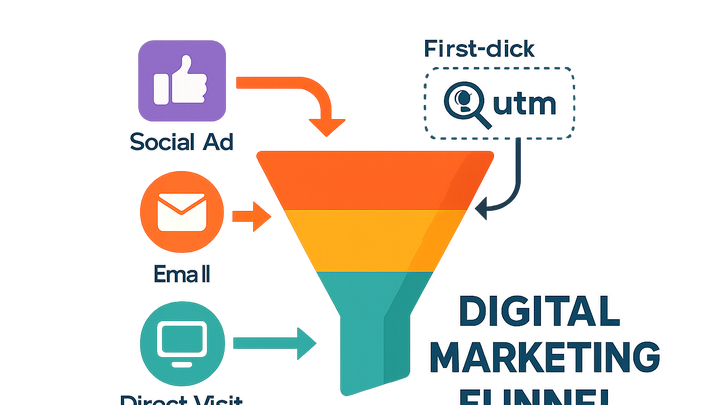Published on 2025-06-29T18:22:07Z
What is First-Click Attribution? Examples and Best Practices
First-Click Attribution is an analytics model that gives full credit for a conversion to the first marketing channel or campaign that brought a user to your site.
It helps marketers understand which channels are most effective at introducing new potential customers by capturing the initial touchpoint—often tracked via UTM parameters, referrer data, or cookie-free solutions like Plainsignal.
This model is simple to implement and interpret, but it may undervalue channels that influence the buying decision later in the journey.
Tools like UTMguru streamline the creation and management of UTM-tagged URLs, ensuring consistent data collection and easy analysis.
When used alongside other attribution models, First-Click Attribution offers valuable insights into early engagement and channel effectiveness.
First-click attribution
First-Click Attribution assigns conversion credit to the initial marketing touchpoint, highlighting which channels drive first engagement.
How First-Click Attribution Works
This section explains how First-Click Attribution tracks the first marketing touchpoint—using tools like UTM parameters or cookie-free analytics—and assigns full conversion credit to that initial interaction.
-
Identifying the initial touchpoint
First-Click models record the very first interaction a visitor has with your campaign, usually by reading UTM parameters (source, medium, campaign) or referral data.
-
Assigning conversion credit
Once a user completes a conversion event, the entire credit is attributed back to that first touchpoint, regardless of subsequent visits or engagements.
Advantages and Drawbacks
Understanding the benefits and limitations helps marketers determine when to rely on first-click data and when to supplement it with other models.
-
Key advantages
First-Click Attribution simplifies credit assignment and provides clear insights into which channels generate initial awareness.
- Easy implementation:
Requires minimal setup compared to complex multi-touch or algorithmic models.
- Highlights awareness channels:
Shows which marketing efforts are most effective at capturing early interest.
- Easy implementation:
-
Common limitations
Focusing only on the first touch can lead to an incomplete understanding of the full customer journey.
- Ignores mid- and bottom-funnel touchpoints:
Overlooks channels like email nurturing, retargeting ads, and customer support interactions.
- Potential for skewed budget allocation:
May cause overinvestment in top-of-funnel channels while underfunding those that drive later conversions.
- Ignores mid- and bottom-funnel touchpoints:
Implementing with Plainsignal and UTMguru
Learn how to set up First-Click Attribution using PlainSignal’s cookie-free analytics and UTMguru’s UTM builder for consistent campaign tracking.
-
Plainsignal setup
Integrate PlainSignal’s tracking script to capture initial touchpoints without relying on cookies.
- Add tracking script:
Paste the following code before the closing </body> tag on your pages:
<link rel="preconnect" href="//eu.plainsignal.com/" crossorigin /> <script defer data-do="yourwebsitedomain.com" data-id="0GQV1xmtzQQ" data-api="//eu.plainsignal.com" src="//cdn.plainsignal.com/plainsignal-min.js"></script> - Verify data collection:
Check the PlainSignal dashboard to confirm that the first touchpoints are being recorded correctly.
- Add tracking script:
-
Creating utm parameters with utmguru
Use UTMguru to generate and manage UTM-tagged URLs, ensuring consistent tagging across campaigns.
- Build and save utm urls:
Define utm_source, utm_medium, utm_campaign, and save URL templates for future reuse.
- Use the chrome extension:
Quickly create UTM parameters directly in your browser when drafting campaign links.
- Build and save utm urls:
Best Practices for First-Click Attribution
Adopt strategies to improve the accuracy and usefulness of first-click data in your marketing analysis.
-
Maintain consistent utm naming conventions
Standardize terminology and casing in UTM parameters to avoid fragmented data entries.
-
Combine with other attribution models
Pair first-click insights with multi-touch or data-driven models to gain a holistic view of the customer journey.
